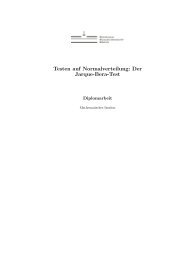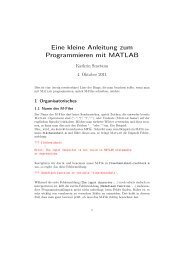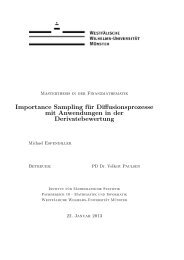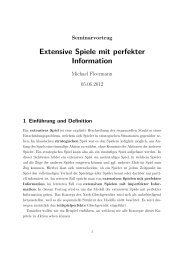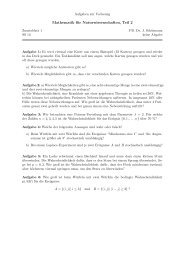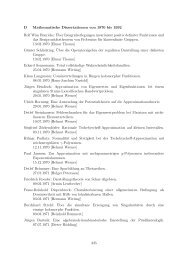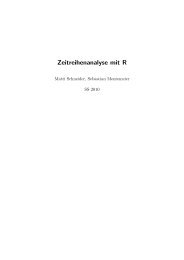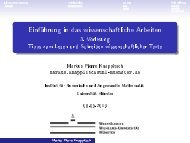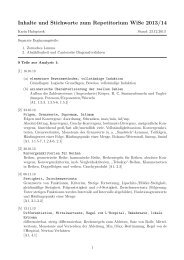Margulis Lemma
Margulis Lemma
Margulis Lemma
You also want an ePaper? Increase the reach of your titles
YUMPU automatically turns print PDFs into web optimized ePapers that Google loves.
46 VITALI KAPOVITCH AND BURKHARD WILKING<br />
There is nothing to prove if R ≤ 2R 0 /3. Suppose the statement holds for R ′ ≤<br />
R − D. We claim it holds for R.<br />
Let a ∈ B 3R/2 (e) \ B R0 (e). By the definition of the metric on A i , there are<br />
g 1 , . . . , g l ∈ A i with d(e, g j ) ≤ 10D, a = ∏ l<br />
j=1 g j and d(e, a) = ∑ l<br />
j=1 d(ˆp, g j ˆp). If<br />
there is any choice we assume in addition that l is minimal with these properties. By<br />
assumption l ≥ R0<br />
10D<br />
= k. By the choice of k, after a renumbering, we may assume<br />
that d(g 1 , g 2 ) ≤ D. Our assumption on l being minimal implies that d(e, g 1 g 2 ) ><br />
10D and we may assume 4D ≤ d(e, g 1 ) ≤ d(e, g 2 ). Thus,<br />
d ( e, g −2<br />
1 a) ≤ d ( e, (g 1 g 2 ) −1 a ) + D = d(e, a) − d(e, g 1 ) − d(e, g 2 ) + D<br />
≤ d(e, a) − 2d(e, g 1 ) + D ≤ d(e, a) − 7D.<br />
By assumption, this implies that g1 −2 a has distance ≤ R 0 to some b 2 ∈ A i with<br />
d(e, b) ≤ 3( 2 d(e, a)−2d(e, g1 )+D ) . Consequently, a has distance ≤ R 0 to g1b 2 2 ∈ A i<br />
with d(e, g 1 b) < 2 3d(e, a). This finishes the proof of the subclaim.<br />
Since the Ricci curvature of ˆMi is bounded below and the L-bilipschitz embedding<br />
ι i maps the ball B 50R0 (e) ⊂ A i to a subset of B 50R0 (ˆp i ), we can use Bishop–<br />
Gromov once more to see that there is a number Q > 0 (independent of i) such<br />
that the ball B 50R0 (e) ⊂ A i can be covered by Q balls of radius R 0 for all i.<br />
We now claim that the ball B 2R (e) ⊂ A i can be covered by Q balls of radius R for<br />
1<br />
all R ≥ 20R 0 and all i. This will clearly imply that<br />
diam(A A i) i is precompact in the<br />
Gromov–Hausdorff topology and that the limits have finite Hausdorff dimension.<br />
Consider the homomorphism<br />
h 8 : A i → A i , x ↦→ x 16 .<br />
It is obviously 16-Lipschitz since A i is abelian. Choose a maximal collection of<br />
points p 1 , . . . , p l ∈ B 2R (e) ⊂ A i with pairwise distances ≥ 2R 0 .<br />
5<br />
From the subclaim it easily follows that B 3R (e) ⊂ ⋃ l<br />
i=1 B 50R 0<br />
(h(p i )). Hence we<br />
can cover B 3R (e) by l · Q balls of radius R 0 .<br />
Consider now a maximal collection of points q 1 , . . . , q h ∈ B 2R (e) with pairwise<br />
distances ≥ R. In each of the balls B 2R (q i ) we can choose l points with pairwise<br />
5<br />
distances ≥ 2R 0 . Thus, B 3R (e) contains h · l points with pairwise distances ≥ 2R 0 .<br />
Since we have seen before that B 3R (e) can be covered by l · Q balls of radius R 0 ,<br />
this implies h ≤ Q as claimed.<br />
Thus,<br />
1<br />
diam( ˆM i)<br />
ˆM i is precompact in the Gromov–Hausdorff topology. After pass-<br />
1<br />
ing to a subsequence we may assume that ˆM<br />
diam( ˆM i → T. Notice that T comes<br />
i)<br />
with a transitive action of an abelian group. Therefore T itself has a natural group<br />
structure. Moreover, T is an inner metric space and the Hausdorff dimension of T is<br />
finite. Like Gromov in [Gro81] we can now deduce from a theorem of Montgomery<br />
Zippin [MZ55, Section 6.3] that T is a Lie group and thus, a torus.<br />
By <strong>Lemma</strong> 10.1, this shows π 1 ( ˆM i ) is infinite for large i – a contradiction.<br />
□<br />
Final Remarks<br />
We would like to mention that in [Wil11] the following partial converse of the<br />
<strong>Margulis</strong> <strong>Lemma</strong> (Theorem 1) is proved.



